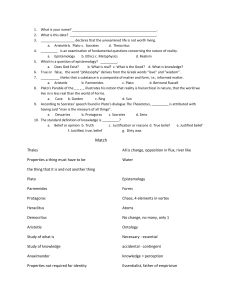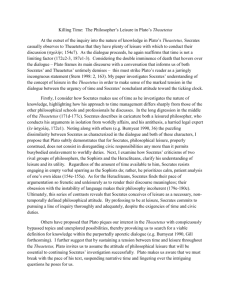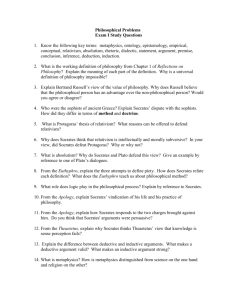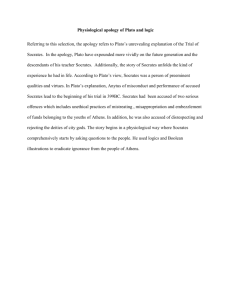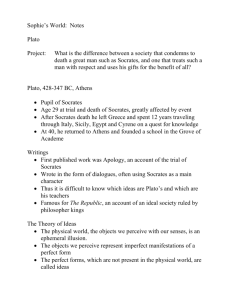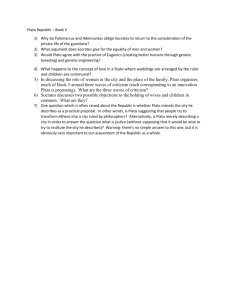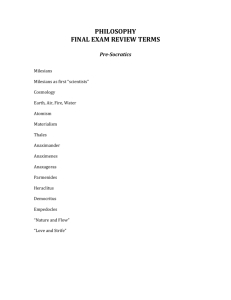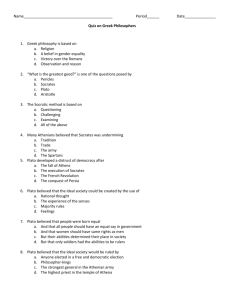From Plato'sTheaetetusto Gauss's Pentagramma Mirificum:A Fight
advertisement
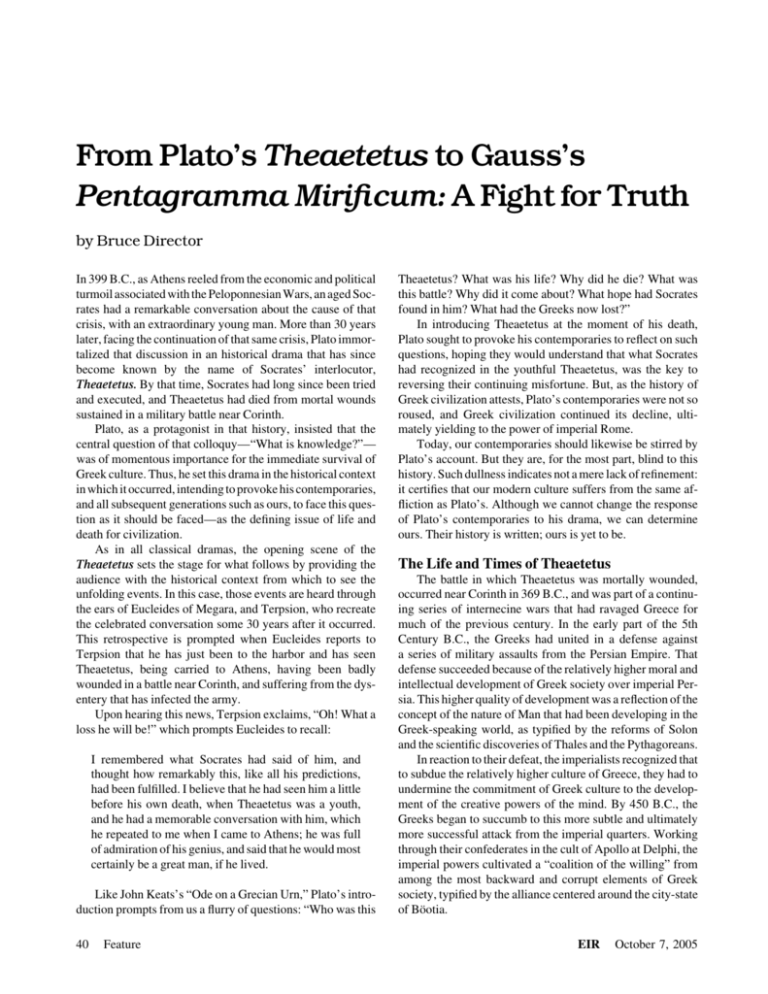
From Plato’s Theaetetus to Gauss’s Pentagramma Mirificum: A Fight for Truth by Bruce Director In 399 B.C., as Athens reeled from the economic and political turmoil associated with the Peloponnesian Wars, an aged Socrates had a remarkable conversation about the cause of that crisis, with an extraordinary young man. More than 30 years later, facing the continuation of that same crisis, Plato immortalized that discussion in an historical drama that has since become known by the name of Socrates’ interlocutor, Theaetetus. By that time, Socrates had long since been tried and executed, and Theaetetus had died from mortal wounds sustained in a military battle near Corinth. Plato, as a protagonist in that history, insisted that the central question of that colloquy—“What is knowledge?”— was of momentous importance for the immediate survival of Greek culture. Thus, he set this drama in the historical context in which it occurred, intending to provoke his contemporaries, and all subsequent generations such as ours, to face this question as it should be faced—as the defining issue of life and death for civilization. As in all classical dramas, the opening scene of the Theaetetus sets the stage for what follows by providing the audience with the historical context from which to see the unfolding events. In this case, those events are heard through the ears of Eucleides of Megara, and Terpsion, who recreate the celebrated conversation some 30 years after it occurred. This retrospective is prompted when Eucleides reports to Terpsion that he has just been to the harbor and has seen Theaetetus, being carried to Athens, having been badly wounded in a battle near Corinth, and suffering from the dysentery that has infected the army. Upon hearing this news, Terpsion exclaims, “Oh! What a loss he will be!” which prompts Eucleides to recall: I remembered what Socrates had said of him, and thought how remarkably this, like all his predictions, had been fulfilled. I believe that he had seen him a little before his own death, when Theaetetus was a youth, and he had a memorable conversation with him, which he repeated to me when I came to Athens; he was full of admiration of his genius, and said that he would most certainly be a great man, if he lived. Like John Keats’s “Ode on a Grecian Urn,” Plato’s introduction prompts from us a flurry of questions: “Who was this 40 Feature Theaetetus? What was his life? Why did he die? What was this battle? Why did it come about? What hope had Socrates found in him? What had the Greeks now lost?” In introducing Theaetetus at the moment of his death, Plato sought to provoke his contemporaries to reflect on such questions, hoping they would understand that what Socrates had recognized in the youthful Theaetetus, was the key to reversing their continuing misfortune. But, as the history of Greek civilization attests, Plato’s contemporaries were not so roused, and Greek civilization continued its decline, ultimately yielding to the power of imperial Rome. Today, our contemporaries should likewise be stirred by Plato’s account. But they are, for the most part, blind to this history. Such dullness indicates not a mere lack of refinement: it certifies that our modern culture suffers from the same affliction as Plato’s. Although we cannot change the response of Plato’s contemporaries to his drama, we can determine ours. Their history is written; ours is yet to be. The Life and Times of Theaetetus The battle in which Theaetetus was mortally wounded, occurred near Corinth in 369 B.C., and was part of a continuing series of internecine wars that had ravaged Greece for much of the previous century. In the early part of the 5th Century B.C., the Greeks had united in a defense against a series of military assaults from the Persian Empire. That defense succeeded because of the relatively higher moral and intellectual development of Greek society over imperial Persia. This higher quality of development was a reflection of the concept of the nature of Man that had been developing in the Greek-speaking world, as typified by the reforms of Solon and the scientific discoveries of Thales and the Pythagoreans. In reaction to their defeat, the imperialists recognized that to subdue the relatively higher culture of Greece, they had to undermine the commitment of Greek culture to the development of the creative powers of the mind. By 450 B.C., the Greeks began to succumb to this more subtle and ultimately more successful attack from the imperial quarters. Working through their confederates in the cult of Apollo at Delphi, the imperial powers cultivated a “coalition of the willing” from among the most backward and corrupt elements of Greek society, typified by the alliance centered around the city-state of Böotia. EIR October 7, 2005 These ancient populists were corrupted and recruited by money, power, and cult religious beliefs, which paid homage to the irrational mystery powers of mythical gods, who considered human beings as beasts. The imperial faction had a common hatred for the concept of Man expressed through the ideas of Solon, Heraclitus, Thales, and the Pythagoreans: that the creative powers of the mind distinguished man from all other creatures. Unlike animals, which are slaves of senseperception, human beings can grasp, through their minds, the unsensed principles of change that govern the behavior of the objects of sense. The Pythagoreans called such principles by the Greek word “dynamis,” whose English translation is “power.” When this cognitive power, not the objects of sense, guides Man’s actions, Man gains an increasing mastery over the physical universe itself. Thus, as Solon set forth in his laws, and Socrates affirmed through his life’s work, the only way to improve the human condition is to improve the powers of the mind. The imperial powers were aided in their corruption of Greek culture by the Sophists, who began to swarm into Athens during the middle of the 5th Century, charging large fees to teach the children of wealthy Athenians how to use the skills of oratory to persuade others to part with their money, morality, and sense. Like ancient Elmer Gantrys, or the antecedents of today’s financial or political consultants, the success of the Sophists depended on the population’s growing willingness to pursue the delusion of sensual power and money—just as today’s Baby Boomers fall for every hallucinatory sex and money scheme that oozes out of the internet. The Sophists, accepting the denial of the existence of human creativity as an axiom, insisted, therefore, that nothing could be known except that which is perceived through the senses. Everything else is simply a matter of “opinion,” whose truth is determined solely by its popularity of the moment. For the Sophists, and those who believed in them, truth did not exist, because it would interfere with the illusory power that sophistry had apparently produced. As the popularity of the Sophists grew, the conditions in Greece declined, leading to the disastrous Peloponnesian Wars from 431 to 404 B.C., which left most of Greece decimated, and Athens in a state of extreme economic, cultural, and political decay. But the wars did not end in 404 B.C. They continued as shifting alliances that pitted each against all, in a permanent war that devoured the Greek-speaking world. In 369 B.C., an army of Sparta and Athens, which had been allies against the Persians, but turned into enemies in the Peloponnesian Wars, combined anew in a battle against the remnants of the morally corrupt, Persian-controlled, Böotian league. It was in this battle that Theaetetus received the wounds that took his life. But, thirty years earlier, Theaetetus was still a youth growing up in an Athens riddled with the corruption of sophistry. This was the circumstance of his memorable discussion with Socrates. EIR October 7, 2005 Theaetetus and Socrates in Dialogue That conversation is reported in Plato’s drama through the reading of the transcript that Eucleides made of Socrates’ account of that day. As that transcript reports, the conversation opened with a discussion between Socrates and Theodorus of Cyrene, a Pythagorean known for his investigations into incommensurable magnitudes. Socrates, expressing his concern for the future of Athens, asks, “Who among these young Athenians shows promise as a philosopher?” Theodorus points out one, the aforementioned Theaetetus, who, he says: . . . is no beauty, and you must not be offended if I say that he is very like you; for he has a snub nose and projecting eyes, although these features are less marked in him than in you. Seeing then, that he has no personal attractions, I may freely say, that in all my acquaintance, which is very large, I never knew any one who was his equal in natural gifts: for he has a quickness of apprehension which is almost unrivaled, and he is exceedingly gentle, and also the most courageous of men; there is a union of qualities in him such as I have never seen in any other, and should scarcely have thought possible; for those who, like him, have quick and ready and retentive wits; have generally also quick tempers; they are ships without ballast, and go darting about, and are mad rather than courageous; and the steadier sort, when they have to face study, prove stupid and cannot remember. Whereas he moves surely and smoothly and successfully in the path of knowledge and enquiry; and he is full of gentleness, flowing on silently like a river of oil; at his age, it is wonderful. With this glowing introduction, Socrates invites Theaetetus to explore a question, which the Sophists insisted could not be answered, and should not be asked: “What does it mean to know something?” With Theodorus’ urging, Theaetetus joins in. Socrates initiates the discussion with a series of questions designed to establish that he is not referring to knowledge of a specific thing, but to the general principle of knowledge itself. In response, Theaetetus says, confidently: Yes, Socrates, there is no difficulty as you put the question. You mean, if I am not mistaken, something like what occurred to me and to my friend, your namesake Socrates, in a recent discussion. Theodorus here was drawing some figures for us in illustration of powers [dynamis], showing that squares containing 3 square feet and 5 square feet are not commensurable in length with the unit of the foot, and so, selecting each one in its turn up to the square containing 17 square feet and at that he stopped. Now it occurred to us, since the number of powers appeared to be infiFeature 41 FIGURE 1 Theodorus’ Construction 1 1 1 __ __ 3 √ __ __ √ 4 √2 √5 1 __ √6 1 ___ __ √17 √7 _ _ _ __ √16 √8 _ _ _ __ √9 ___ √15 ___ ___ √14 √10 ___ ___ √13 √11 √12 1 1 1 1 1 1 1 1 1 1 1 1 Theodorus’ construction of incommensurable magnitudes. He stopped at 17, but Theaetetus conceived of the entire unlimited class of such “square” powers and found their true boundary. nite, to try to collect them under one name by which we could henceforth call all the powers. Theaetetus then demonstrates to Socrates how he had surpassed his teacher and discovered a general principle of incommensurables. (See Figure 1.) Not a specific principle for this or that incommensurable magnitude, he says, but the general principle—power (dynamis) from which these incommensurables are generated. The Idea of Powers This idea of powers is at the heart of all science from that time to this. The simple example used by Theaetetus—that the powers that increase a line are distinct from the powers that increase an area, which are, in turn, distinct from the powers that increase a volume—is an expression of the capacity of the human mind to be a master, not a slave, of the objects of sense. From their visible appearance, the line, square, and cube all appear to be generated by the same thing. The square is bounded by lines; the cube is bounded by squares. The edge of a cube and the side of the square are lines, which, in their visible appearance are indistinguishable from a simple line itself. Yet, as the Pythagoreans discovered, the line that generates a square is incommensurable with a simple line, and the line that generates a cube is incommensurable with both other lines. Theaetetus went further. He recognized that the line which doubles a square is incommensurable with the line that triples a square which, in turn, is incommensurable with the line that quadruples a square, and so on. But although these magnitudes are each separate and distinct, they could be thought of as expressions of a single principle. That principle, although apparently unlimited, was actually bounded; it lacked the 42 Feature power to double the cube. Those cubic powers, Theaetetus asserted, were a different species of powers. Upon hearing Theaetetus present his discovery, Socrates proclaims with great joy that Theodorus is fully justified to praise the cognitive powers of his student. But now Socrates posed the more elementary question, “What do you mean when you say you know something?” This caused Theaetetus to caution that he does not deserve the praise, because he cannot answer that general question. Eucliedes’ transcript provides the account of what follows: Socrates: Well, but if some one were to praise you for running and to say that he never met your equal among boys and afterwards you were beaten in a race by a grown-up man, who was a great runner would the praise be any the less true? Theaetetus: Certainly not. Socrates: And is the discovery of the nature of knowledge so small a matter, as I just now said? Is it not one which would task the powers of men perfect in every way? Theaetetus: By heaven they should be the top of all perfection! Socrates: Well, then, be of good cheer; do not say that Theodorus was mistaken about you, but do your best to ascertain the true nature of knowledge, as well as of other things. Theaetetus: I am eager enough, Socrates, if that would bring to light the truth. Socrates: Come, you made a good beginning just now; let your own answer about powers be your model, and as you comprehended them all in one class, try and bring the many sorts of knowledge under one definition. Plato’s drama continues the account of this historic conversation in which the venerable Socrates, concerned for the future of his country which he has seen decay through the corruption of sophistry, seeks to instill in the young genius a ruthless commitment for the truth, and an understanding of the method by which to seek it. Socrates implores Theaetetus to use his personal experience of a creative discovery as a guidon for pursuing the more fundamental question. Throughout the dialogue Socrates encourages Theaetetus to trust only his knowledge of the power of discovery, not the knowledge of specific things. Socrates recognizes that although this creative experience can only take place in the individual human mind, society as a whole depends on its frequent occurrence. Therefore, he insists, that as an old man concerned for what will become of mankind after his death, he must be dedicated to inspiring this capacity in others. He compares himself to his mother, who as a midwife, helped bring children into this world, whereas he helps bring forth ideas. He seeks to inspire in Theaetetus a passion for truth so strong, that as he assumes greater responEIR October 7, 2005 sibility for society, he will be willing to subject his thoughts to the scrutiny necessary to determine whether he has produced something true, or has merely brought forth a “wind egg.” If Socrates succeeds in this effort, he will have created a warrior against sophistry. For the full account, the reader is referred to Plato’s dialogue (see www.perseus.tufts.edu for translation), but for our purposes here we must underscore Socrates’ concluding remark: If after this you ever undertake to conceive other thoughts, Theaetetus, and do conceive, you will be pregnant with better thoughts than these by reason of the present search, and if you remain barren, you will be less harsh and gentler to your associates, for you will have the wisdom not to think you know that which you do not know. So much and no more my art can accomplish; nor do I know aught of the things that are known by others, the great and wonderful men who are today and have been in the past. This art, however, both my mother and I received from God, she for women and I for young and noble men and for all who are fair. And now I must go to the Porch of the King, to answer the indictment which Meletus has brought against me. But in the morning, Theodorus, let us meet here again. Meletus’ indictment charged Socrates with impiety and corrupting the youth, for his opposition to sophistry in Athens. At the trial, Socrates warned that if Athens continued to capitulate to sophistry it would pay a heavy price. He was convicted and executed. The history records, as Eucleides noted, that all Socrates’ forecasts were fulfilled. Enter Archytas Within two years of Theaetetus’ death, Plato was called to Syracuse by a coalition of Pythagoreans who were fighting a western flank against Persian-led imperialism. Plato had visited this region 25 years earlier, shortly after the death of Socrates, in his search for potential collaborators against the Persian-allied sophists. This first trip would have brought him into proximity with circles around Archytas, a great statesman and scientist based in the Pythagorean stronghold of Tarentum. Among Archytas’ scientific accomplishments were a thorough study of music, astronomy, mechanics, and his famous solution to the problem of doubling the cube. Archytas had established himself as one of the most important political leaders in the region, having been elected general for seven years, although the usual term was one. As a Pythagorean, he insisted that politics must be guided by scientific principles, not sophistry. These Pythagoreans of Sicily and southern Italy had hoped to influence Dionysius II, the tyrant of Syracuse, to reject sophistry and return to the traditions of Solon. But this effort failed, and Plato soon returned to Athens believing the Syracusans to be too corrupt to heed his advice. Although at the time Plato considered his EIR October 7, 2005 assessment final, in 361 B.C., Archytas personally implored him to return to the region, in another attempt to solidify a flank against sophistry. Respecting Archytas’ judgment, Plato made the trip, only to find himself sentenced to death by a Dionysius more intent on pursuing his power, than on turning his kingdom into a republic. But through the direct intervention of Archytas, Plato was freed, and returned to Athens, where, among other things, he wrote the dramatic account of Theaetetus’ conversation with Socrates. In the years that followed, Plato continued to emphasize the importance of the connection between science and politics. In the Laws, his final attempt to guide Greek culture out of the pit into which it had fallen, Plato laments that the Athenians were “like guzzling swine,” because they had become ignorant of the principles for doubling the square and cube. Such ignorance left the Greeks not only unaware of basic scientific principles; more important, lacking a direct, personal experience of creative discovery, they had been rendered like beasts. Plato’s emphasis on the relationship between this development of the creative powers of the individual human mind and the condition of society as a whole, was immortalized by Eratosthenes’ characterization of the problem of doubling the cube as the “Delian” problem. According to Theon of Smryna, Eratosthenes wrote in his Platonicus: [W]hen the god proclaimed to the Delians by the oracle that, if they would get rid of a plague, they should construct an altar double of the existing one, their craftsmen fell into great perplexity in their efforts to discover how a solid could be made double: They therefore went to ask Plato about it, and he replied that the oracle meant, not that the god wanted an altar of double the size, but that he wished, in setting them the task, to shame the Greeks for their neglect of mathematics and their contempt for geometry. In Plato’s dialogue, Theaetetus alludes to this Delian Problem, when, after recounting to Socrates his discovery of the entire species of square magnitudes, he says, “and the same for solids.” We do not know how far Theaetetus’ knowledge of solids had extended when he was at this age; however, the later history shows that it was Theaetetus who produced the first complete study of the Egyptian/Pythagorean science of the five regular, spherical, “Platonic” solids. The significance of Theaetetus’ allusion to solids in this context becomes clear, only when viewed from the standpoint of Archytas’ solution to the Delian problem. Inversely, Archytas’ solution to the Delian problem can only be understood, when viewed from the standpoint of Theaetetus’ history. As Theaetetus indicated in his youthful discussion, the incommensurable magnitudes associated with the square powers, though distinct, can be thought of as a single power. Feature 43 FIGURE 2 FIGURE 3 (a) Doubling and Powers Two Means Between Two Extremes P (a) (b) C O A Q A The chord OP is the geometric mean between OQ and OA. As P moves from A to O, the entire manifold of such proportions (one mean between two extremes) is formed. B (c) 3 1 √ 2 3 ( √2 ) 2 2 (a) The magnitude which has the “power” to double the length of a line is produced by simple extension. (b) The magnitude which has the power to produce a square of double area is the diagonal of the smaller square, and is called the geometric mean between the two squares. The magnitude of diagonal BC is incommensurable with, and cannot be produced by, the magnitude of side AB of the smaller square. (c) The magnitude which has the power to produce a cube of double volume is different from the magnitudes which have the power to double a square, or a line. It is the smaller of two geometric means between the two cubes, and is incommensurable with both lower magnitudes. This unity is expressed harmonically by the proportion of one geometric mean between two extremes. However, as was discovered by Hippocrates of Cios a generation earlier, the incommensurable magnitudes associated with the cubic powers, are expressed harmonically by the proportion of two geometric means between two extremes. (See Figure 2.) As Plato expressed it in the Timaeus, it is the real universe, not formal mathematics, that defines which of these proportions is real: If the body of the All had to come into existence as a plane surface, having no depth, one mean would have sufficed to bind together both itself and its fellow-terms; but now it is otherwise: for it behooved it to be solid of shape, and what brings solids into unison is never one mean alone but always two. Plato’s, Archytas’ and Theaetetus’ focus on the Delian problem drove the Sophists crazy, for the Sophists insisted that nothing could be known to be true but sense perception. 44 Feature FIGURE 3 (b) P A Q O D To generate two means between two extremes, the motion of 3(a) must itself be moved, to pivot around O. Thus Q moves simultaneously on line AO and on circle DQO. Circle OPA sweeps out the surface of a torus. Line PQ sweeps out the surface of a cylinder. P moves simultaneously on the circumference of circle APO and the curve (not shown) formed by the intersection of the torus and the cylinder. Consequently, the Sophists could never double the cube, because, as Archytas’ solution shows, the cube cannot be doubled by any method that is apparent to sense perception. Because one mean between two extremes can be expressed by the motion of a right angle in a circle, it would seem, from the standpoint of sense-perception, that two means could be expressed by a similar motion in a sphere. (See Figure 3.) This false belief is further reinforced by the fact that the cube, as one of the five regular solids, can be EIR October 7, 2005 FIGURE 4 Archytas Doubles the Cube When a cone, with its apex at O, is formed by extending chord OM and rotating it until it intersects both the torus and the cylinder at P, two geometric means are formed. OM:OQ::OQ:OP::OP:OA. If OM is 1, OQ will be the edge of the cube whose volume is 2, OP will be the edge of the cube whose volume is 4, and OA will be the edge of the cube whose volume is 8. perfectly inscribed and circumscribed by a sphere. But Archytas showed that the action that produces two means between two extremes is not merely spherical. It requires the complex of actions that generates an intersection between a torus, cylinder, and cone. (See Figure 4.) This higher form of action (as indicated below) belongs to the domain which Gauss and Riemann would later call “hypergeometric.” The Sophists and their imperialist controllers were faced with the problem of desiring the results of scientific discovery, while, at the same time, demanding the suppression of the creative powers of the mind that produced those results. They set about to promulgate a new form of cult-religion masquerading as science. This dogma was codified by Aristotle, an imperial agent dedicated to smothering the method of the Pythagoreans and Plato. The virtually satanic creed of Aristotle, transmogrified into various forms such as empiricism, reductionism, information theory, and so on, has been the primary weapon wielded aginst science by the carriers of the imperial cause from that day to the present. Crusading under the banner of “objective science,” Aristotle’s minions explored, not the real world, but the horrific fantasy world which the oligarchy sought to bring about: a world devoid of human creativity. After all, objectively, the human mind is a part of the real universe. Thus, the only true science, is one that is objectively, subjective. Aristotle’s form of sophistry is exemplified by the method and organization of Euclid’s Elements. EIR October 7, 2005 Euclid and the Sophistry of the Elements The Elements are built on a scaffold of axioms, postulates, and definitions that are not, and never could be, proven. At the heart of this scaffold is the assumption that physical space is linearly extended, infinitely, in three mutually orthogonal directions. Upon this scaffold, Euclid builds an edifice of theorems that derive, by logical deduction, a compendium of results that begins with the plane figures, ends with the five regular solids, and sandwiches the theory of incommensurables in between. Not only does this entire structure crumble, if the assumptions on which it is based are proven not to be true (which they are not); but, even more important, nothing in these Elements could have been, nor was, discovered by Euclid’s method. For example, the entire section on the five regular solids and the theory of incommensurables, was lifted directly from the works of Theaetetus. But they appear here in a form deliberately antagonistic to the method of Archytas, Theaetetus, and Plato. Where Euclid began with definitions, axioms, and postulates, Theaetetus began with an experimentally derived discovery that the magnitudes that double a square are of a different power than the magnitudes that double a line. He then tested this discovery and found its boundary: it could not double the cube. Yet, as Plato emphasized in the Timaeus, physical reality demands the discovery of a higher principle. As Archytas’ construction shows, that higher (cubic) principle is itself bounded and generated by a still higher principle of action, the hypergeometric. It is important to underscore, that the fallacy of Euclid’s Elements is one of design. It cannot be overcome by tricks, such as reversing the order of the Elements to begin with the spherical constructions and descend to the plane figures. Euclid and Theaetetus investigated entirely different objects. The solids of Euclid are mechanical objects; Euclid describes their visible characteristics. The solids of Theaetetus, Archytas, and Plato are the immaterial, yet substantial, dynamic processes that produce the visible solids. As the Archytas construction demonstrates, and as the case of Gauss’s pentagramma mirificum confirms on a more advanced level, the spherical solids are themselves reflections of a “hyperspherical” form of action. Such hyperspherical, or more generally, hypergeometrical, domains can only be discovered, as the history of ideas affirms, by the Socratic method typified by Plato, Theaetetus, and Archytas. As Plato’s account of Theaetetus’ conversation with Socrates attests, this method uniquely can obtain truthful results, because it reflects the fact that the fundamental nature of humanity, creativity, is a universal characteristic. The Hypergeometric Domain This anti-Euclidean method of the ante-Euclideans, Plato, Theaetetus, and Archytas, established the basis for all progress in science since their time. On the other hand, as Riemann stated in his 1854 habilitation dissertation, the AristoteleanFeature 45 sophistical method of Euclid had produced a darkness over science that had inhibited progress from that time to his. That darkness began to be lifted with the work of Kepler, who applied the Socratic method of Nicholas of Cusa’s De Docta Ignorantia to the determination of the physical planetary orbits. Kepler first showed, in his 1596 Mysterium Cosmographicum, that the relationships among the visible planets corresponded to the relationship among Theaetetus’ five regular spherical “Platonic” solids. This, however, implied that the planet’s orbits were circular. But as he stated in the opening of his New Astronomy, the experimental evidence showed that the planetary orbits were not perfect circles. “This leads to a powerful sense of wonder that drives men to look into causes [dynamis].” Kepler pursued this paradox in opposition to the “Euclidean” methods of Ptolemy, Copernicus, and Tycho Brahe, who all investigated the physics of the planetary orbits from the standpoint of the Aristotelean mathematics of perfect circles. Rejecting this approach, Kepler was committed to revolutionizing astronomy and returning to the Socratic approach exemplified by Theaetetus and Archytas. In this way, Kepler demonstrated that the orbits of the planets were, in fact, elliptical. This led him to his next discovery, that these elliptical orbits were harmonically related according to the same proportions that human beings use to communicate ideas through bel canto polyphonic music. Such proportions did not conform to whole-number ratios, but—as Kepler emphasized through his attack on the Aristotelean Petras Ramus—to the incommensurable magnitudes that had been investigated by Theaetetus. This fact is another indication of the hypergeometric characteristic of the Solar System. Kepler provided us with a retrospective of his own thoughts in the context of the history we have here recounted, in his 1612 introduction to the second edition of The Mysterium Cosmographicum. In the first edition, Kepler had emphasized that his discoveries were not only based on the results of the Pythagoreans and Plato concerning the five regular solids, but on their method as well—as that method had been advanced by Cusa. In his original dedication, he had stressed not only his results, but the Socratic-Cusan nature of Man that his discovery of these results affirmed: . . . [W]hen we perceive how God, like one of our own architects, approached the task of constructing the universe with order and pattern, and laid out the individual parts accordingly, as if it were not art which imitated Nature, but God himself had looked to the mode of building of Man who was to be. In the intervening 25 years between editions, Kepler had superseded his own discoveries, but the German-speaking world of central Europe had descended deeper into bloody religious war, along with the rise of a modern form of sophistry known as empiricism. In his introduction to the second 46 Feature edition, Kepler notes that although he has made many advances over his original discovery, he had decided not to change anything of substance in the original work. This was so his readers could judge his method of thinking from the retrospective of his subsequent achievements, and thus be able to recognize, in the manner of Plato’s Theaetetus, the creative process itself. But Kepler also wanted his readers to judge his discoveries in the context of their subsequent history. For in the years that followed the first edition, the Venetianorchestrated religious conflict, which had been simmering for more than a century, erupted into the orgy of destruction and insanity, known today as the Thirty Years’ War. Thus, Kepler, like Plato, insisted that his contemporaries, and future generations as well, view his science, as it should be viewed, as a matter of life and death for civilization. Would that even now indeed there may still, after the reversal of Austrian affairs which followed, be a place for Plato’s oracular saying. For when Greece was on fire on all sides with a long civil war, and was troubled with all the evils which usually accompany civil war, he was consulted about a Delian Riddle, and was seeking a pretext for suggesting salutary advice to the peoples. At length he replied that, according to Apollo’s opinion, Greece would be peaceful if the Greeks turned to geometry and other philosophical studies, as these studies would lead their spirits from ambition and other forms of greed, out of which wars and other evils arise, to the love of peace and to the moderation in all things. Kepler’s discoveries raised anew what had already been exposed by Archytas’ solution to the “Delian” problem: specifically, the tension between the apparently spherical form of the visible domain, and the hypergeometric nature of the dynamics of physical action. A deeper insight into this tension can be seen through Gauss’s investigation into the “pentagramma mirificum.” The pentagramma mirificum had originally been investigated by Kepler’s contemporary, John Napier. In the context of developing advances in spherical astronomy, Napier had begun to uncover the hypergeometric origin of the characteristics of spherical action. His discovery involved the construction of a chain of right spherical triangles, which he called “the pentagramma mirificum.” (See Figure 5.) But the deeper significance of this construction only emerges with Gauss’s investigations, as reported in two sets of fragments from his notebooks. Although the implications of Gauss’s exploration of the pentagramma mirificum are quite broad, the epistemological significance can be illustrated with reference to only a few of the results. In his first fragment, Gauss investigates the relationship between the characteristics of a spherical pentagramma mirificum and the plane pentagon generated from it by central projection. (See Figure 6.) As the figure illustrates, the characteristics of the plane pentagon are nothing more than artiEIR October 7, 2005 FIGURE 5 (a) FIGURE 5(b) Napier’s Pentagramma Mirificum Gauss’s Sketch of Napier’s Pentagramma Mirificum B A p q C t r E s D John Napier’s Pentagramma Mirificum is formed from a chain of spherical right triangles. On a sphere, both the angles and the sides of a triangle are measured as angles. Thus, angles A, B, C, D, E are all right angles. Arcs pC, qD, rE, sA, tB, are all 90 degrees. The spherical pentagon is self-polar, which means that each vertex is the pole of the opposite side. For example, p is the pole of the equator sr; q is the pole of equator st, and so on. The sides and angles of the spherical triangles Atp, Bpq, Cqr, Drs, and Est are permutations of each other. This construction cannot be performed on a plane, because on a plane a similar chain of right triangles produces a quadrilateral, not a pentagram. Thus, Napier’s Pentagramma Mirificum brings to light the intrinsic five-fold periodicity of the sphere. This fivefold periodicity is also reflected by the fact, as Theaetetus and Kepler showed, that the five regular Platonic solids all can be generated from the pentagon-based dodecahedron. facts of the characteristics of the spherical pentagramma mirificum from which it was projected. This indicates what Gauss emphasized from his earliest work until his death: the Euclidean plane does not exist! But this spherical pentagramma also has a higher origin. In fragments five through twelve, Gauss shows how the spherical pentagramma, and its projection, are both artifacts of an elliptical function, which itself is an artifact of a superseding hypergeometry. (See Figure 7.) Kästner’s Anti-Euclidean Methods Gauss’s discoveries with respect to the pentagramma mirificum reflect his ardent commitment to anti-Euclidean methods, to which he was recruited by his first teachers, E.A.W. Zimmerman and Abraham Gotthelf Kästner. Kästner, who was the primary defender of Kepler, Leibniz, and Bach for most of the 18th Century, was a master pedagogue. With Zimmerman and others, Kästner helped to implement Leibniz’s design for an educational system that focussed on developing the creative powers of the students, through an EIR October 7, 2005 Source: Gauss, Werke, Book 3, p. 481. emphasis on a mastery of language and the self-study of the original classics of science and art in their historical context. His 1758 seven volume, Mathematical Elements, presents the principal discoveries of science known at that time, as a series of pedagogical exercises designed to facilitate the student’s personal recreation of them—exactly the opposite approach to the mind-deadening method of Euclid’s Elements. Kästner’s 1796 four-volume History of Mathematics from the Restoration of Science until the end of the 18th Century, provides a polemical overview of the historical context for those discoveries, emphasizing the superiority of the Socratic method, as typified by Leonardo, Cusa, and Kepler, and as distinct from the Aristotelean sophistries typified by Galileo and Newton. In addition to these works on science, Kästner was a leading figure in the development of classical art, writing volumes of polemical epigrams, poems, and aesthetical essays. Among his students was the dramatist Gotthold Lessing, the collaborator of Moses Mendelssohn, who was responsible for reviving Shakespeare, and establishing the foundations for the German classical stage. Gauss called Kästner, “the first poet among mathematicians and the first mathematician among poets.” Among Kästner’s most notable polemics was his direct attacks on the stupidity of Euclid’s Elements. In numerous essays, as well as the above-mentioned works, Kästner took aim at the Element’s Achilles heel: the parallel postulate. Kästner insisted that this postulate, sometimes also referred to as the 11th axiom, which asserted that parallel lines exist, could never be proven and rests solely on the false assumption Feature 47 FIGURE 6(a) FIGURE 6(b) Pentagramma Mirificum Projected Self-Polar Spherical Pentagon Gauss considered the plane pentagon as the central projection of the spherical pentagramma mirificum. Under central projection, the spherical arcs are transformed into straight-lines, and consequently, the angles are changed. that space is flat, and infinitely linearly extended. Were this assumption to be proven false, by physical experiment, the parallel postulate would not be true, and the entire theorem lattice of Euclidean geometry would be exposed as the fantasy world that it is. Gauss picked up on Kästner’s investigations early on, writing in his notebooks in 1797, at the age of 20, that the “possibility of the plane” (that is, the Euclidean flatness of space), must first be proven. Gauss’s later work on the pentagramma mirificum is an extension of this youthful rejection of Euclideanism. Kästner’s fight against sophistry pitted him directly against the imperial cause centered around the British East India Company: the descendants of the banking circles associated with the enemies of Socrates, Plato, Archytas, and Theaetetus in the cult of Apollo at Delphi. This put him into a direct alliance with the leading scientist of the time, America’s Benjamin Franklin, whom he hosted when Franklin visited Göttingen in July 1766. It also made him the direct adversary of the leading imperial sophists of the day, Euler, D’Alembert, and Lagrange. Gauss was one of Kästner’s last students. Born one year after the American Declaration of Independence, he grew up in a more hopeful time than Theaetetus. The hope portended by the successful establishment of the American Republic and the influence of his Leibnizian sponsors, especially the then-aged Kästner, inspired in Gauss a passionate rejection of sophistry. This youthful passion was expressed in his 1799 doctoral dissertation, later called the Fundamental Theorem of Algebra, in which he exposed the shallowness of the impe48 Feature On the self-polar spherical pentagon, the altitude lines can be made to intersect at any point inside the pentagon. This is because any great-circle arc on a sphere drawn from a pole will be perpendicular to the equator. rialists’ leading scientific authorities, Euler, Lagrange, and D’Alembert. Gauss, like Kästner and Plato, was also aware of the connection between the influence of sophistry in science and the political conditions of society. In his “Introductory Lecture on Astronomy,” first delivered circa 1805, Gauss underscored the importance for the betterment of society as a whole, of the improvement of the creative powers of the individual mind. Attacking those sophists who would belittle astronomy by asking, “What use is such a science?” Gauss said: It is not a good sign of the spirit of the time if one hears such a question brought up often and repeatedly. It bespeaks partly an unhappy incongruity between the necessities of life (or those “needs” considered necessary) and the resources for satisfying them; it is a silent confession of a truly unpraiseworthy degree of dependence on those needs if one believes oneself compelled to relate everything to our physical needs, if one demands a justification or occupation with a science and cannot comprehend that there are people who study merely because studying is for them a necessity. However, not merely our poverty proves (by documents) such a manner of judging to be at once a petty, narrowminded, and lazy way of thinking, a disposition always to calculate nervously the reward of every pithy utterance, an indifference and insensibility to the great and to that which honors humanity. Unfortunately, one cannot conceal the fact that one finds such a mode of thinking very prevalent in our age, and it is probably quite certain EIR October 7, 2005 FIGURE 6(c) FIGURE 7 Gauss’s Projected Pentagon The Pentagramma Mirificum As an Elliptical Function Source: Gauss, Werke, Book 3, p. 483. Gauss’s sketch of the projected pentagon. The altitude lines intersect at one point. This is an artifact of the spherical characteristic of 6(b). When Gauss expressed the vertices of the plane pentagon with complex numbers, he showed that all the apparent characteristics of a plane pentagon were artifacts of their spherical origins, regardless of whether the sphere is drawn or not. That is, the Euclidean plane does not exist! that this attitude is very closely connected with the ill fortune which of late has struck so many states. Understand me correctly, I am not speaking of the very frequent lack of feeling for the sciences themselves, but of the source from which this flows, of the tendency everywhere to ask first about the advantage and to relate everything to physical well-being, of the indifference to great ideas, of the aversion to effort due merely to pure enthusiasm for the thing in itself. I mean that such characteristics if they are very predominating, could have been a decisive intervention in the catastrophes which we have experienced. . . . At the time this speech was first delivered, the American cause in Europe had become increasingly suppressed, after the British-directed orgy of sophistry known as the French Revolution, and the rise of modern fascism in the form of the satanic Joseph de Maistre’s Napoleon Bonaparte. These are the “ill-fortunes” and “catastrophes” to which Gauss refers in his lecture. With this change in the political climate, the death of Kästner in 1800, the takeover of the Ecole Polytecnique by Napoleon’s “favorite mathematician,” Lagrange, and Napoleon’s retaliatory direct personal attack on him, Gauss became increasingly cautious about expressing his anti-Euclidean views. Nevertheless, his entire life’s work continued to be guided by this epistemological direction, and all of his imporEIR October 7, 2005 Source: Gauss, Werke, Book 8, p. 114. Because the projected pentagon lies in a plane that cuts the projection cone at an angle, the projected pentagon will be inscribed in an ellipse. Thus, the spherical pentagramma mirificum expresses an elliptical function. Gauss showed that when this relationship is expressed in the complex domain, the pentagramma mirificum provides a partial solution to the “Kepler Problem”: the division of the ellipse into five parts. Gauss considered the positions P1 , P2, etc., as the positions of a planet in an elliptical orbit, and the angles that OP1′, OP2′, etc. make with the axis, as the “eccentric anomalies.” He then found a relationship between these eccentric anomalies and the elliptical arcs P1 P2, P2 P3, P3 P4, P4 P5, P5 P1 in terms of an elliptic function. Gauss generalized from this that this elliptic function was a special case of a more general hypergeometric domain, which Riemann showed was expressed by the domain of Abelian Functions. Thus, the characteristics of the sphere, as exemplified by the pentagramma mirificum, are themselves artifacts of the higher, unseen, hypergeometric domain. tant discoveries are the result of it. Under these conditions of virtual imperial dictatorship, especially from the 1815 Congress of Vienna onward, Gauss only explicitly expressed his anti-Euclidean convictions in private correspondence with his closest collaborators. In those circumstances, he emphatically said that he was a committed anti-Euclidean, but he could never publish his views, because it would provoke “the outcry of the Böotians.” Shortly before his own death, Gauss was privileged to attend the habilitation lecture of his last and most promising student, Bernhard Riemann, On the Hypotheses that Underlie the Foundations of Geometry. On that occasion, much to Gauss’s delight, Riemann stated publicly what his teacher never said. And the Böotians, whom Theaetetus had died fighting, have not stopped shrieking to this day. Feature 49
